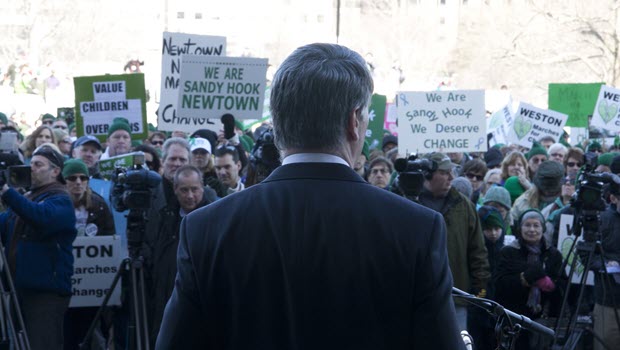Teachers around Connecticut are thinking about the students and educators we lost in Newtown 10 years ago today. With heavy hearts, we remember the grief of that day, which has only increased with each subsequent school shooting.
CEA Executive Director Donald Williams served as president of the Connecticut State Senate in 2012, and helped pass the state’s gun safety legislation. In an op-ed published over the weekend in Hearst Connecticut newspapers and others, he remembers the tragedy and discusses what we must do to stop mass shootings in our schools.
Read the op-ed by Williams (pictured speaking at a February 2013 rally at the State Capitol), below.
The Tragedy and Legacy of Sandy Hook
On December 14, 2012, Connecticut and our country suffered a horrific tragedy at Sandy Hook Elementary School. Gun violence against young children in our schools was still unthinkable at that time.
Earlier on that day, as President of the State Senate, I joined other legislative leaders for an annual press office holiday luncheon. As we conversed with reporters, holding paper plates with finger food, the TV monitors issued a bulletin—a mass shooting had taken the lives of multiple elementary school children, teachers, and administrators in Newtown. Our reactions were visceral—it was hard to breath. The shockwaves in that room and throughout the nation were paralyzing, and the magnitude of the terrible loss demanded action.
We later learned that in just four minutes, 154 shots were fired, taking the lives of twenty children, and six educators defending their students. The United States is one of the few countries that allows easy access to semi-automatic weapons designed for warfare, and high-capacity magazines designed for mass shootings.
In the days that followed, state leaders in both parties reached out to each other to express our grief, and to discuss a possible bi-partisan path forward. Despite the steady drumbeat of mass shootings in America, the issue of gun violence prevention continues to be one of the most partisan and divisive issues. Not surprisingly, there was pressure in the legislature to settle for “low-hanging fruit,” such as a bill that only strengthened background checks, a bill that might get the vote of every legislator. But the parents, friends, and relatives of the children and adults who were murdered raised their voices. They were powerful advocates for the strongest bill possible, and challenged us to remember their loved ones, and make it harder for such tragedies to occur in the future.
A committee with legislators from both parties gathered research, public input, and made recommendations. A hearing with anguished testimony was held in Newtown. Then, the four leaders of the legislature met; I joined House Speaker Brendan Sharkey, Senate Minority Leader John McKinney, House Minority Larry Cafero, and our staff, to consider the recommendations and final legislation.
Given the acrimony surrounding gun legislation, I frankly doubted that a strong, bi-partisan solution would be possible, but thought the pursuit was imperative. Agreement from both parties would send a powerful message to the rest of the country. During a series of meetings, we worked through our respective doubts and political suspicions—and there was a pivot point. John McKinney, who represented Newtown, understood that progress must be made. John was with some of the parents after the shootings as they gathered at a firehouse and waited to learn the fate of their children. Larry Cafero also wanted meaningful change, and proposed distinctions regarding firearms used for hunting and competitive target shooting that proved important in drafting the legislation. Brendan Sharkey and I favored restrictions on semi-automatic rifles and high capacity magazines. We all agreed on background checks and more resources for mental health and our schools.
In the end we reached agreement on what is arguably the strongest gun violence prevention legislation in the country. It is the only bi-partisan bill of its scope and kind. It prohibited the sale of semi-automatic rifles such as the AR-15, high-capacity magazines that hold more than ten bullets, required background checks for the purchase of guns and ammunition, increased penalties for gun-related crimes, provided additional resources for mental health treatment, and expanded security resources and planning for schools. With bi-partisan leadership, the bill passed the Senate and House with large majorities, including most Democrats and nearly half of all Republican legislators.
Despite bi-partisan agreement in Connecticut, the past ten years have been filled with more mass shootings at schools, churches and synagogues, shopping malls, convenience stores, workplaces, concerts, and wherever people gather. The tragedy is that research demonstrates that gun violence protection laws save lives. Studies in the American Journal of Public Health and elsewhere show that legislation that restricts access to semi-automatic weapons such as AR-15s and high capacity magazines, and laws requiring background checks, help stop mass shootings and all gun violence. Polling shows that the majority of Americans consistently support such common-sense measures. This year, U.S. Senator Chris Murphy helped achieve the first breakthrough in decades at the national level—a bi-partisan bill that requires background checks for gun sales and prohibits sales to convicted domestic abusers. More must be done to save lives.
Ten years ago in Connecticut, when young children and the educators who tried to protect them were killed in a mass shooting, legislators put aside partisan gridlock in the wake of one of our nation’s worst violent tragedies. Today, that is the least we should expect.







